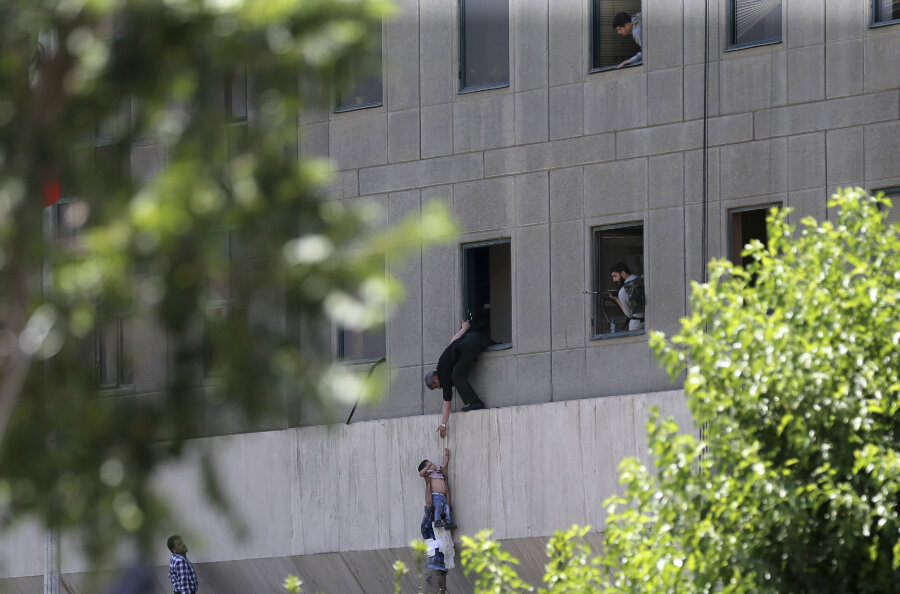Anxiety in Arab-nation dispute rises with ISIS-claimed attacks in Iran
Loading...
| Tehran, Iran
The Islamic State group claimed responsibility Wednesday for a stunning pair of attacks on Iran's parliament and the mausoleum of its modern founder, the first such attack claimed by the Sunni extremist group in the Shiite-ruled nation.
The lethal assaults, which killed at least 12 people and shocked the country, brought Iran's wars in Iraq and Syria to its capital at a time when emboldened Sunni Arab states – led by Saudi Arabia and backed by US President Trump – harden their position on its Shiite leadership.
The attacks drew condemnations and condolences from the governments of Pakistan and from Iran's close allies in the Russian and Syrian governments.
The attacks began midmorning when assailants, armed with Kalashnikov rifles and explosives, stormed the parliament building. One of the attackers later blew himself up inside, where a session had been in progress, according to Iran's state TV.
It was an hours-long siege at the legislature that ended with four attackers dead. In images circulating in Iranian media, gunmen were seen holding rifles near the windows of parliament. Another image, carried in the semi-official Fars news agency, showed a toddler being handed off through a first-floor window to safety outside as an armed man looks on.
The IS group's Aamaq news agency released a 24-second video purportedly shot inside the parliament building during the siege. The video, circulated online, shows a bloody, lifeless body of a man lying on the ground next to a desk.
A voice on the video praises God and says in Arabic: "Do you think we will leave? We will remain, God willing." Another voice repeats the same words. The two appeared to be parroting a slogan used by IS spokesman Abu Mohammad al-Adnani, who was killed in Syria last year.
As the parliament siege was unfolding, gunmen and suicide bombers attacked the shrine of Iran's revolutionary leader, Ayatollah Ruhollah Khomeini, which is located just outside Tehran. Mr. Khomeini, who died in 1989, is a towering figure in Iran who led the 1979 Islamic revolution that toppled the Western-backed shah and became its first supreme leader.
Iranian Parliament Speaker Ali Larijani called the attacks a cowardly act and proof that Tehran has made an enemy of militant Islamic groups through its policies and actions in Iraq and Syria.
"Iran is an active and effective pillar in the fight against terrorists and they want to damage it," he said.
The two attacks, which wounded dozens of people, are likely to deepen enmity and the regional battle for power between Saudi Arabia and Iran. Already, tensions are high following a cut in ties this week between four Arab countries and Qatar over accusations it supports terrorist groups and is aligning itself too closely with Iran.
Both Saudi Arabia and Iran accuse one another of policies that support extremists in the region. Saudi Arabia has long pointed to the absence of IS attacks on Iran as suggestion of Tehran's culpability. Iran, on the other hand, has pointed to Saudi Arabia's support for jihad throughout different times in history and its backing of hard-line Sunni rebels groups in Syria.
Saudi Arabia has itself been a target of numerous lethal attacks by IS affiliates in the Arabian Peninsula, who see the kingdom's Western-allied leadership as heretics. The group has also targeted Shiites in Saudi Arabia and Kuwait.
The group's militants are directly at war with Iranian-backed forces in Syria and Iraq, and view Shiites as apostates.
Deputy Interior Minister Mohammad Hossein Zolfaghari told Iran's state TV the apparently male attackers wore women's attire. The semi-official Tasnim news agency later reported the siege had ended with four of the attackers killed.
Mizan Online, an Iranian state-run news website, said 12 people were killed and 42 wounded in the two attacks. It quoted Pirhossein Kolivand, the head of Iran's emergency department.
An Associated Press reporter saw several police snipers on the rooftops of buildings around the parliament. Shops in the area were shuttered, and gunfire could be heard. Witnesses said the attackers were shooting from the fourth floor of the parliament building down at people in the streets below.
"I was passing by one of the streets. I thought that children were playing with fireworks, but I realized people are hiding and lying down on the streets," Ebrahim Ghanimi, who was around the parliament building when the assailants stormed in, told The Associated Press. "With the help of a taxi driver, I reached a nearby alley."
Police helicopters circled over the parliament building and all mobile phone lines from inside were disconnected. The semi-official ISNA news agency said all entrances and exit gates at parliament were closed and that lawmakers and reporters were ordered to remain in place inside the chamber during the siege.
Soon after the parliament attack, a suicide bomber and other assailants targeted the mausoleum of Khomeini, located just outside the capital, Tehran, according to Iran's official state broadcaster. It said a security guard was killed and that one of the attackers was killed by security guards. A woman was also arrested.
An Associated Press reporter saw security forces, some uniformed and others in plainclothes, around the large and ornate shrine.
The IS group often claims attacks around the world, even when links to the group cannot be confirmed and appear dubious. Iranian security officials have not said who they suspect is behind the attacks, though state media has referred to the attackers as "terrorists."
The unusual attacks prompted the Interior Ministry to call for an urgent security meeting. Officials at one point urged people to avoid using public transportation until further notice.







